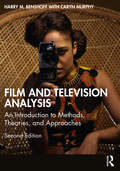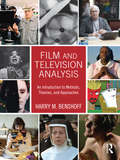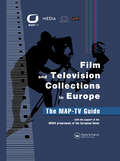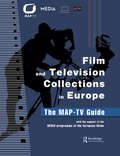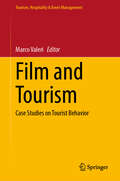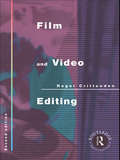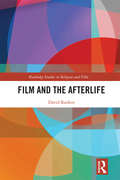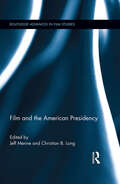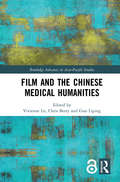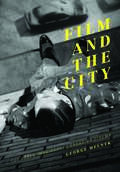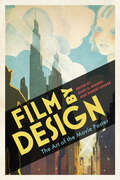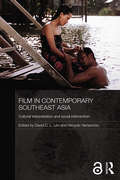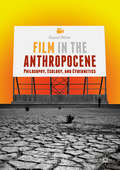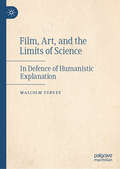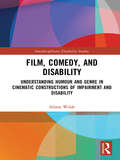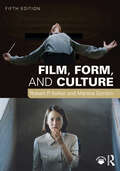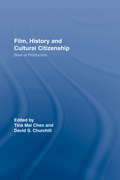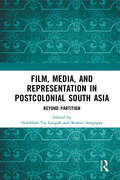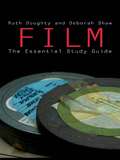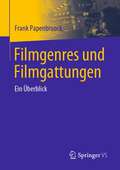- Table View
- List View
Film and Television Analysis: An Introduction to Methods, Theories, and Approaches
by Harry M. Benshoff Caryn MurphyThis fully revised second edition textbook is especially designed to introduce undergraduate students to the most important qualitative methodologies used to study film and television. The methodologies covered in Film and Television Analysis include: ideological analysis, auteur theory, genre theory, semiotics and structuralism, psychoanalysis and apparatus theory, feminism, postmodernism, cultural studies (including reception and audience studies), and contemporary approaches to race, nation, gender, and sexuality. With each chapter focusing on a distinct methodology, students are introduced to the historical developments of each approach, along with its vocabulary, significant scholars, key concepts, and case studies. Features of the second edition include: new and updated case studies to accompany each chapter over 130 color images throughout questions for discussion at the end of each chapter suggestions for further reading a glossary of key terms Written in a reader-friendly manner, Film and Television Analysis is a vital textbook for students encountering these concepts for the first time.
Film and Television Analysis: An Introduction to Methods, Theories, and Approaches
by Harry M. Benshoff Caryn MurphyThis fully revised second edition textbook is especially designed to introduce undergraduate students to the most important qualitative methodologies used to study film and television.The methodologies covered in Film and Television Analysis include: ideological analysis, auteur theory, genre theory, semiotics and structuralism, psychoanalysis and apparatus theory, feminism, postmodernism, cultural studies (including reception and audience studies), and contemporary approaches to race, nation, gender, and sexuality. With each chapter focusing on a distinct methodology, students are introduced to the historical developments of each approach, along with its vocabulary, significant scholars, key concepts, and case studies.Features of the second edition include: new and updated case studies to accompany each chapter over 130 color images throughout questions for discussion at the end of each chapter suggestions for further reading a glossary of key terms Written in a reader-friendly manner, Film and Television Analysis is a vital textbook for students encountering these concepts for the first time.
Film and Television Analysis: An Introduction to Methods, Theories, and Approaches
by Harry BenshoffFilm and Television Analysis is especially designed to introduce undergraduate students to the most important qualitative methodologies used to study film and television. The methodologies covered include: ideological analysis auteur theory genre theory semiotics and structuralism psychoanalysis and apparatus theory feminism postmodernism cultural studies (including reception and audience studies) contemporary approaches to race, nation, gender, and sexuality. With each chapter focusing on a distinct methodology, students are introduced to the historical developments of each approach, along with its vocabulary, significant scholars, key concepts and case studies. Other features include: Over 120 color images throughout Questions for discussion at the end of each chapter Suggestions for further reading A glossary of key terms. Written in a reader-friendly manner Film and Television Analysis is a vital textbook for students encountering these concepts for the first time.
Film and Television Collections in Europe - the MAP-TV Guide
by Eureka AudiovisuelThe MAP-TV Guide to film and television collections in Europe provides detailed information on almost 2,000 sources and archives of film and television in over forty European countries. This authoritative volume includes: the title listing of each collection both in English and the local language; research information; a subject and keyword index; an introduction to the collections in each country. This work will be of importance to all film researchers, production companies, film makers, archivists and reference librarians.
Film and Television Collections in Europe: The MAP-TV Guide
by Daniela KirchnerPublished in 1995, "Film & Television" is an important contribution to Film and Media.
Film and Television Production in the Age of Climate Crisis: Towards a Greener Screen (Palgrave Studies in Media and Environmental Communication)
by Hunter Vaughan Pietari KääpäThis volume brings together a range of voices from across the global environmental media community to build a comparative international set of perspectives on ‘green’ film and television production. Through this, it provides a necessary intervention in environmental media studies that actively foregrounds media infrastructure, production, policy, and labour – that is, the management and practice of media production cultures.Due to its immense sociocultural influence and economic resources, the global screen media industry is at the forefront of raising awareness for the political and social issues resulting from accelerated environmental instability. However, the 21st century relationship between screen media and the environment has another face that demands urgent scrutiny. The advent of the digital age and the vast electrical and Information and Communication Technologies (ICT) infrastructures required to support digital production, distribution, and archiving has resulted in the rapid expansion and diversification of the industry’s resource use, infrastructure construction, energy dependency, and consequent waste and emissions production. Addressing these structures is essential to alleviating their environmental and social impact and ensuring that the industry’s rhetoric on environmental responsibility is reflected in its practice.As a mitigating counterbalance to the above trends, there has been a heightenedpush for sustainability measures along various lines of industry management, policy, and practice. These initiatives—including the cultural values they reflect, the political economies that form their logic, the managerial and marketing tactics that orchestrate them, and the environmental realities of their implementation—form the central object of inquiry for this collection.
Film and Tourism: Case Studies on Tourist Behavior (Tourism, Hospitality & Event Management)
by Marco ValeriFilm tourism has emerged as a major driver of tourism development for many destinations. To date, there has been substantial literature on the subject, but little of it has engaged with the wider social science paradigm of culture, film and media research. The intellectual components of film tourism as an area of academic inquiry span several academic subjects such as marketing, economics, finance, psychology, social development, sustainability, and operations. Film is a relatively obscure area of tourism research, but the wider interconnections between tourism, space and media are beginning to be explored and understood. The interest which the topic has generated highlights this subject as one that is worthy of attention within both the academic community and in a practitioner context. The contributions in this book discuss the debates about the perceived and actual impact of film tourism and what must still be learned about this phenomenon to create the most unique and satisfying visitor experiences and protect the communities and environments that it affects. Fundamental questions are raised regarding the real demand for and draw of film as a tourism motivator, and the range of assumptions, conflicts, and contradictions that underlie them.
Film and Video Editing
by Roger CrittendenFirst published in 1995. Routledge is an imprint of Taylor & Francis, an informa company.
Film and the Afterlife (Routledge Studies in Religion and Film)
by David RankinThis book explores how post-death existence is represented in popular film, looking at issues such as continuity, personal identity, and the nature of existence beyond the grave. Film often returns to the theme of dying, death and the afterlife, both directly and indirectly, because there are very few subjects as compelling and universal. The book compares the representation of death, dying and the afterlife in films to scholarly surveys of attitudes towards life-after-death through the analysis of twenty films made between the end of World War II and now. It looks at the portrayals of stages between death and a final destination; spatio-temporal and personal continuity; the nature of afterlife existence in terms of embodiment, or not; and the contact between the worlds of the living and the dead. This book offers a wide-ranging view on a compelling subject in film. As such, it will be of great interest to scholars of Religion and Film, Religion and Media, the Philosophy of Religion, and the Sociology of Religion, as well as Religion, Media and Film Studies more generally .
Film and the American Presidency (Routledge Advances in Film Studies)
by Jeff Menne Christian B. LongThe contention of Film and the American Presidency is that over the twentieth century the cinema has been a silent partner in setting the parameters of what we might call the presidential imaginary. This volume surveys the partnership in its longevity, placing stress on especially iconic presidents such as Lincoln and FDR. The contributions to this collection probe the rich interactions between these high institutions of culture and politics—Hollywood and the presidency—and argue that not only did Hollywood acting become an idiom for presidential style, but that Hollywood early on understood its own identity through the presidency’s peculiar mix of national epic and unified protagonist. Additionally, they contend that studios often made their films to sway political outcomes; that the performance of presidential personae has been constrained by the kinds of bodies (for so long, white and male) that have occupied the office, such that presidential embodiment obscures the body politic; and that Hollywood and the presidency may finally be nothing more than two privileged figures of media-age power.
Film and the Chinese Medical Humanities (Routledge Advances in Asia-Pacific Studies)
by Chris Berry Vivienne Lo Guo LipingFilm and the Chinese Medical Humanities is the first book to reflect on the power of film in representing medical and health discourse in China in both the past and the present, as well as in shaping its future. Drawing on both feature and documentary films from mainland China, the chapters each engage with the field of medicine through the visual arts. They cover themes such as the history of doctors and their concepts of disease and therapies, understanding the patient experience of illness and death, and establishing empathy and compassion in medical practice, as well as the HIV/AIDs epidemic during the 1980s and 90s and changing attitudes towards disability. Inherently interdisciplinary in nature, the contributors therefore provide different perspectives from the fields of history, psychiatry, film studies, anthropology, linguistics, public health and occupational therapy, as they relate to China and people who identify as Chinese. Their combined approaches are united by a passion for improving the cross-cultural understanding of the body and ultimately healthcare itself. A key resource for educators in the Medical Humanities, this book will be useful to students and scholars of Chinese Studies and Film Studies as well as global health, medical anthropology and medical history.
Film and the City: The Urban Imaginary in Canadian Cinema
by George MelynkMost Canadians are city dwellers, a fact often unacknowledged by twentieth-century Canadian films, with their preference for themes of wilderness survival or rural life. Modernist Canadian films tend to support what film scholar Jim Leach calls “the nationalist-realist project,” a documentary style that emphasizes the exoticism and mythos of the land. Over the past several decades, however, the hegemony of Anglo-centrism has been challenged by francophone and First Nations perspectives and the character of cities altered by a continued influx of immigrants and the development of cities as economic and technological centers. No longer primarily defined through the lens of rural nostalgia, Canadian urban identity is instead polyphonic, diverse, constructed through multiple discourses and mediums, an exchange rather than a strict orientation. Taking on the urban as setting and subject, filmmakers are ideally poised to create and reflect multiple versions of a single city. Examining fourteen Canadian films produced from 1989 to 2007, including Denys Arcand’s Jésus de Montréal (1989), Jean-Claude Lauzon’s Léolo (1992), Mina Shum’s Double Happiness (1994), Clément Virgo’s Rude (1995), and Guy Maddin’s My Winnipeg (2007), Film and the City is the first comprehensive study of Canadian film and “urbanity”—the totality of urban culture and life. Drawing on film and urban studies and building upon issues of identity formation in Canadian studies, Melnyk considers how filmmakers, films, and urban audiences experience, represent, and interpret urban spatiality, visuality, and orality. In this way, Film and the City argues that Canadian narrative film of the postmodern period has aided in articulating a new national identity.
Film by Design: The Art of the Movie Poster
by Gary D. Rhodes and Robert SingerContributions by Vlad Dima, Laura Hatry, Alicia Kozma, Lynette Kuliyeva, Madhuja Mukherjee, Frank Percaccio, Gary D. Rhodes, Courtney Ruffner Grieneisen, Marlisa Santos, Michael L. Shuman, and Robert Singer Movie posters, regardless of their country of origin, have become indelibly linked with the films they represent, often assuming a status as visual encapsulations of films within collective memory. Long after their initial role in promotion is complete, these posters endure as iconic images, etched into film history and cultural consciousness. One can hardly hear mention of Steven Spielberg’s landmark production Jaws, for example, without immediately picturing the evocative poster art of Roger Kastel.Film by Design: The Art of the Movie Poster is a groundbreaking and comprehensive exploration of the international and Hollywood movie poster as a dynamic artistic and cultural formation. Drawing inspiration from such prominent genres as horror, science fiction, and noir, the twelve essays in this collection provide insightful analyses of the movie poster as a vital component of the cinematic landscape from the silent era to the contemporary period. Crucially, this anthology rejects the notion of movie posters as mere historical artifacts or advertising tools and instead examines them as integral parts of a broader aesthetic framework interwoven into their respective film narratives. Each chapter, whether focusing on controversies, close-ups, or Cuba, is accessible to scholars, students, and fans alike. Through its intervention in film studies, Film by Design reveals the movie poster to be an ever-evolving medium, firmly grounded in both theory and practice, while serving as an essential and enduring element within the realm of film art.
Film in Contemporary Southeast Asia: Cultural Interpretation and Social Intervention (Media, Culture and Social Change in Asia)
by David C. L. Lim Hiroyuki YamamotoThis book discusses contemporary film in all the main countries of Southeast Asia, and the social practices and ideologies which films either represent or oppose. It shows how film acquires signification through cultural interpretation, and how film also serves as a site of contestations between social and political agents seeking to promote, challenge, or erase certain meanings, messages or ideas from public circulation. A unique feature of the book is that it focuses as much on films as it does on the societies from which these films emerge: it considers the reasons for film-makers taking the positions they take; the positions and counter-positions taken; the response of different communities; and the extent to which these interventions are connected to global flows of culture and capital. The wide range of subjects covered include documentaries as political interventions in Singapore; political film-makers’ collectives in the Philippines, and films about prostitution in Cambodia and patriotism in Malaysia, and the Chinese in Indonesia. The book analyses films from Burma, Laos, Cambodia, Vietnam, Thailand, Malaysia, Singapore, Indonesia and the Philippines, across a broad range of productions – such as mainstream and independent features across genres (for example comedy, patriotic, political, historical genres) alongside documentary, classic and diasporic films.
Film in the Anthropocene: Philosophy, Ecology, and Cybernetics
by Daniel WhiteThis book provides an interdisciplinary analysis of film in the context of the Anthropocene: the new geological era in which human beings have collectively become a force of nature. Daniel White draws on perspectives in philosophy, ecology, and cybernetics (the science of communication and control in animals and machines) to explore human self-understanding through film in the new era. The classical figure of Janus, looking both to the future and the past, serves as a guide throughout the study. Both feature and documentary films are considered.
Film, Art, and the Limits of Science: In Defence of Humanistic Explanation
by Malcolm TurveyThere is currently a vigorous debate in film studies and related disciplines about the extent to which scientific paradigms like evolutionary psychology and neuroscience can explain the cinema and other artforms. This debate tends to devolve into extreme positions, with many film scholars and other humanists insisting that science has little or no role to play in the study of the arts, while a minority contends that it is always needed to fully account for cultural phenomena like film. Malcolm Turvey advocates for a more moderate position. He argues that, while the sciences can explain much about film and the other arts, there is much about these phenomena that only humanistic methods can account for. He thereby mounts a trenchant defence of the purpose and value of humanistic explanation, one that nevertheless acknowledges and welcomes the legitimate contribution of the sciences to the study of the arts.
Film, Comedy, and Disability: Understanding Humour and Genre in Cinematic Constructions of Impairment and Disability (Interdisciplinary Disability Studies)
by Alison WildeComedy and humour have frequently played a key role in disabled people’s lives, for better or for worse. Comedy has also played a crucial part in constructing cultural representations of disability and impairments, contributing to the formation and maintenance of cultural attitudes towards disabled people, and potentially shaping disabled people’s images of themselves. As a complex and often polysemic form of communication, there is a need for greater understanding of the way we make meanings from comedy. This is the first book which explores the specific role of comedic film genres in representations of disability and impairment. Wilde argues that there is a need to explore different ways to synthesise Critical/Disability Studies with Film Studies approaches, and that a better understanding of genre conventions is necessary if we are to understand the conditions of possibility for new representational forms and challenges to ableism. After a discussion of the possibilities of a ‘fusion’ between Disability Studies and Film Studies, and a consideration of the relationships of comedy to disability, Wilde undertakes analysis of contemporary films from the romantic comedy, satire, and gross-out genres. Analysis is focused upon the place of disabled and non-disabled people in particular films, considering visual, audio, and narrative dimensions of representation and the ways they might shape the expectations of film audiences. This book is of particular value to those in Film and Media Studies, and Critical/Disability Studies, especially for those who are investigating more inclusive practices in cultural representation.
Film, Environment, Comedy: Eco-Comedies on the Big Screen (Routledge Advances in Film Studies)
by Robin L. Murray Joseph K. HeumannThis book explores the transformative power of comedy to help connect a wider audience to films that explore environmental concerns and issues. This book offers a space in which to explore the complex ways environmental comedies present their eco-arguments. With an organizational structure that reveals the evolution of both eco-comedy films and theoretical approaches, this book project aims to fill a gap in ecocinema scholarship. It does so by exploring three sections arranged to highlight the breadth of eco-comedy: I. Comic Genres and the Green World: Pastoral, Anti-Pastoral, and Post-Pastoral Visions; II. Laughter, Eco-Heroes, and Evolutionary Narratives of Consumption; and III. Environmental Nostalgia, Fuel, and the Carnivalesque. Examining everything from Hollywood classics, Oscar winners, and animation to independent and international films, Murray and Heumann exemplify how the use of comedy can expose and amplify environmental issues to a wider audience than more traditional ecocinema genres and can help provide a path towards positive action and change. Ideal for students and scholars of film studies, ecocriticism, and environmental studies, especially those with a particular interest in ecocinema and/or ecocritical readings of popular films.
Film, Environment, Comedy: Eco-Comedies on the Big Screen (Routledge Advances in Film Studies)
by Robin L. Murray Joseph K. HeumannThis book explores the transformative power of comedy to help connect a wider audience to films that explore environmental concerns and issues. This book offers a space in which to explore the complex ways environmental comedies present their eco-arguments. With an organizational structure that reveals the evolution of both eco-comedy films and theoretical approaches, this book project aims to fill a gap in ecocinema scholarship. It does so by exploring three sections arranged to highlight the breadth of eco-comedy: I. Comic Genres and the Green World: Pastoral, Anti-Pastoral, and Post-Pastoral Visions; II. Laughter, Eco-Heroes, and Evolutionary Narratives of Consumption; and III. Environmental Nostalgia, Fuel, and the Carnivalesque. Examining everything from Hollywood classics, Oscar winners, and animation to independent and international films, Murray and Heumann exemplify how the use of comedy can expose and amplify environmental issues to a wider audience than more traditional ecocinema genres and can help provide a path towards positive action and change.Ideal for students and scholars of film studies, ecocriticism, and environmental studies, especially those with a particular interest in ecocinema and/or ecocritical readings of popular films.
Film, Form, and Culture
by Robert P. Kolker Marsha GordonThis fifth edition of Film, Form, and Culture offers a lively introduction to both the formal and cultural aspects of film.With extensive analysis of films past and present, this textbook explores how films are constructed from part to whole: from the smallest unit of the shot to the way shots are edited together to create narrative. Robert P. Kolker and Marsha Gordon demystify the technical aspects of filmmaking and demonstrate how fiction and nonfiction films engage with culture. Over 265 images provide a visual index to the films and issues being discussed. This new edition includes: an expanded examination of digital filmmaking and distribution in the age of streaming; attention to superhero films throughout; a significantly longer chapter on global cinema with new or enlarged sections on a variety of national cinemas (including cinema from Nigeria, Senegal, Burkina Faso, South Korea, Japan, India, Belgium, and Iran); new or expanded discussions of directors, including Alice Guy-Blaché, Lois Weber, Oscar Micheaux, Agnès Varda, Spike Lee, Julie Dash, Jafar Panahi, Ava DuVernay, Jane Campion, Jean-Pierre and Luc Dardenne and Penny Lane; and new, in-depth explorations of films, including Within Our Gates (1919), Black Girl (1966), Creed (2015), Moonlight (2016), Wonder Woman (2017), Get Out (2017), Black Panther (2018), Parasite (2019), Da 5 Bloods (2020), The French Dispatch (2021), The Power of the Dog (2021), RRR (2022), and Tár (2022).This textbook is an invaluable and exciting resource for students beginning film studies at undergraduate level.Additional resources for students and teachers can be found on the eResource, which includes case studies, discussion questions, and links to useful websites.
Film, Form, and Culture: Fourth Edition
by Robert KolkerFilm, Form, and Culture (4th edition) offers a lively introduction to both the formal and cultural aspects of film. With extensive analysis of films past and present, this textbook explores film from part to whole; from the smallest unit of the shot to the way shots are edited together to create narrative. It then examines those narratives (both fiction and non-fiction) as stories and genres that speak to the culture of their time and our perceptions of them today. Composition, editing, genres (such as the gangster film, the Western, science fiction, and melodrama) are analyzed alongside numerous images to illustrate the discussion. Chapters on the individuals who make films - the production designer, cinematographer, editor, composer, producer, director, and actor - illustrate the collaborative nature of filmmaking. This new edition includes: An expanded discussion of the digital 'revolution" in filmmaking: exploring the movement from celluloid to digital recording and editing of images, as well as the use of CGI A new chapter on international cinema that covers filmmaking from Italy to Mumbai offering students a broader understanding of cinema on a worldwide scale A new chapter on film acting that uses images to create a small catalogue of gestures and expressions that are recognizable in film after film Expanded content coverage and in-depth analysis throughout, including a visual analysis of a scene from Christopher Nolan's The Dark Knight An expanded chapter on the cultural contexts of film summarizes the theories of cultural and media studies, concluding with a comparative analysis of Alfred Hitchcock's Vertigo and Judd Apatow's This is 40 Over 260 images, many in color, that create a visual index to and illustration of the discussion of films and filmmaking Each chapter ends with updated suggestions for further reading and viewing, and there is an expanded glossary of terms. Additional resources for students and teachers can also be found on the companion website (www.routledge.com/cw/kolker), which includes additional case studies, discussion questions and links to useful websites. This textbook is an invaluable and exciting resource for students beginning film studies at undergraduate level.
Film, History and Cultural Citizenship: Sites of Production (Routledge Studies in Cultural History)
by Tina Mai Chen; David S. ChurchillThis new book investigates the relationship of film to history, power, memory, and cultural citizenship. The book is concerned with two central issues: firstly, the participation of film and filmmakers in articulating and challenging projects of modernity; and, secondly, the role of film in shaping particular understandings of self and other to evoke collective notions of belonging. These issues call for interdisciplinary and multi-layered analyses that are ideally met through dialogue across place, time, identities and genres. The contributors to this volume enable this dialogue by considering the ways in which cultural expression and identity expressed through film serve to create notions of belonging, group identity, and entitlement within modern societies.
Film, Media and Representation in Postcolonial South Asia: Beyond Partition
by Nukhbah Taj LangahThis volume brings together new studies and interdisciplinary research on the changing mediascapes in South Asia. Focusing on India, Pakistan, and Bangladesh, it explores the transformations in the sphere of cinema, television, performing arts, visual cultures, cyber space and digital media, beyond the traumas of the partitions of 1947 and 1971. Through wide-ranging essays on soft power, performance, film, and television; art and visual culture; and cyber space, social media, and digital texts, the book bridges the gap in the study of the postcolonial and post-Partition developments to reimagine South Asia through a critical understanding of popular culture and media. The volume includes scholars and practitioners from the subcontinent to foster dialogue across the borders, and presents diverse and in-depth studies on film, media and representation in the region. This book will be useful to scholars and researchers of media and film studies, postcolonial studies, visual cultures, political studies, partition history, cultural studies, mass media, popular culture, history, sociology and South Asian studies, as well as to media practitioners, journalists, writers, and activists.
Film: The Essential Study Guide
by Ruth Doughty Deborah ShawProviding a key resource to new students, Film: The Essential Study Guide introduces all the skills needed to succeed on a film studies course. This succinct, accessible guide covers key topics such as: Using the library Online research and resources Viewing skills How to watch and study foreign language films Essay writing Presentation skills Referencing and plagiarism Practical Filmmaking Including exercises and examples, Film: The Essential Study Guide helps film students understand how study skills are applicable to their learning and gives them the tools to flourish in their degree.
Filmgenres und Filmgattungen: Ein Überblick
by Frank PapenbroockDieses Buch leistet einen Beitrag zum Verständnis der Bedeutung von Filmgenre-, Gattungs-, Stil- und Formatbezeichnungen. Es verfolgt das Ziel, einen umfassenden Überblick über die vielfältigen, oft wild wuchernden Begrifflichkeiten zu geben, die im Alltag gebräuchlich sind. Dabei beschreibt es in allgemeinverständlicher Sprache die wichtigsten Merkmale, die mit den jeweiligen Bezeichnungen verbunden sind, und arbeitet den Konsens hinsichtlich des dramaturgischen Aufbaus, der Geschichtsstruktur sowie der wiederkehrenden Ikonografie, Musik und Bildsprache heraus.Neben der Vermittlung grundlegender Informationen widmet sich das Buch auch Fragen, die aufgrund der Geläufigkeit der Begriffe oftmals als zu banal angesehen werden und klärt Detailfragen, wie etwa den Unterschied zwischen einem „Sozialdrama“ (engl. „Social Problem Film“) und einem „Social Drama“ (dt. „Gesellschaftsdrama“). Es fungiert somit als Überblick für Filminteressierte jeder Art, insbesondere aber für jene, die beruflich mit dem Thema in Verbindung stehen.
